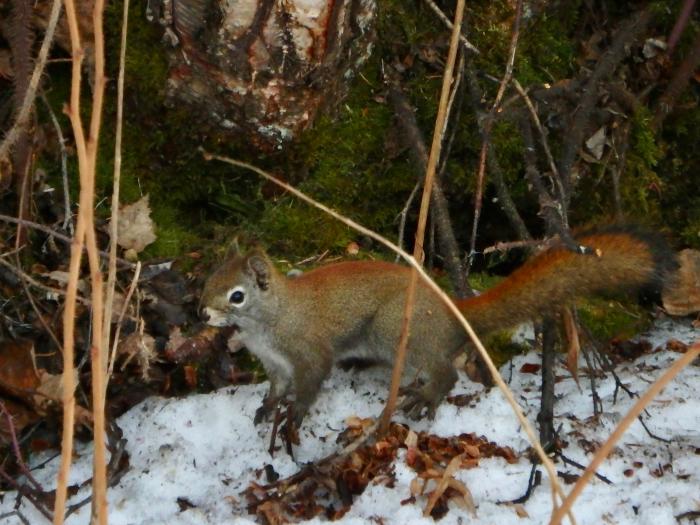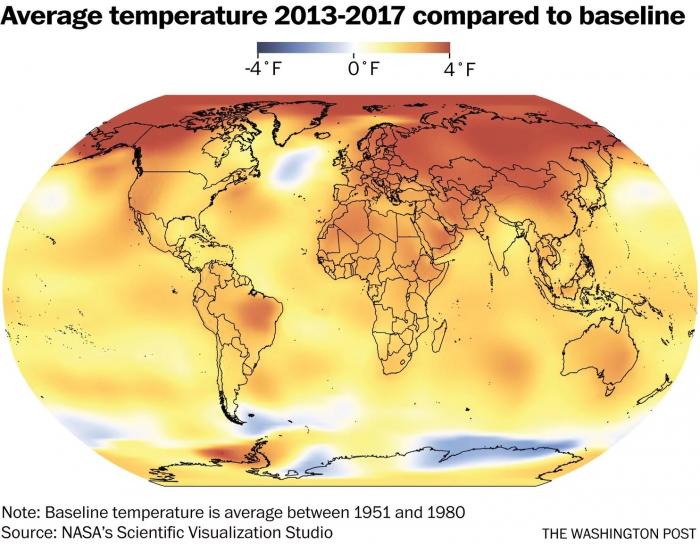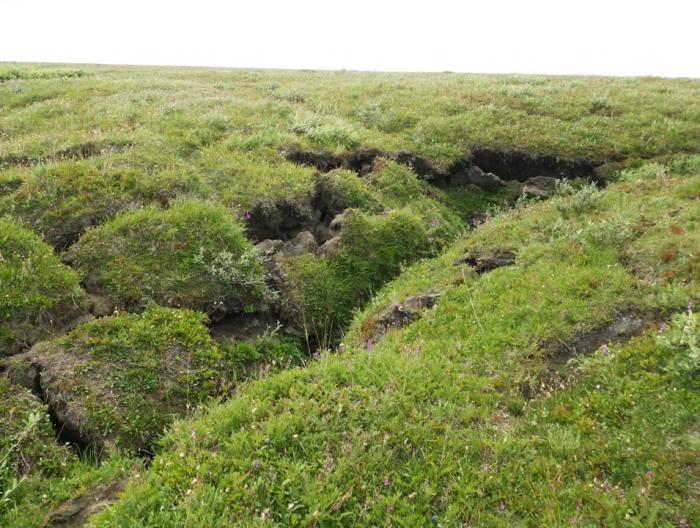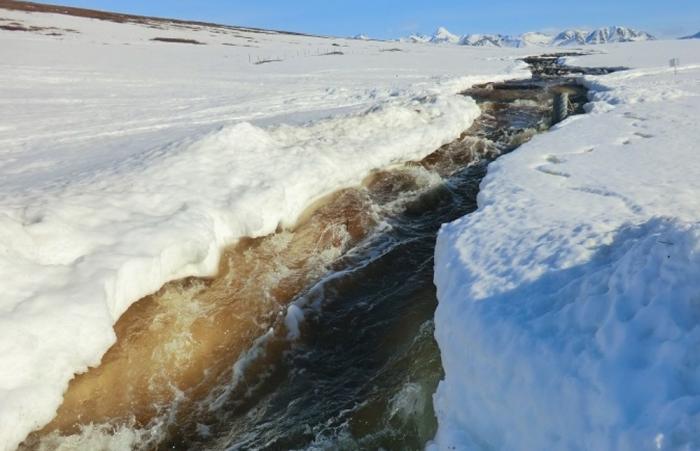Frozen Fuel of Climate ChangeA statistically significant variation in either the mean state of the climate or the mean variability of the climate that persists for an extended period (typically 10 years or more). Climate change may result from such factors as changes in solar activity, long-period changes in the Earth's orbital elements, natural internal processes of the climate system, or anthropogenic forcing (for example, increasing atmospheric concentrations of carbon dioxide and other greenhouse gases).
Austin, Texas
May 11, 2019
Photo of the Day:

Take a brief look into recent research on climate science, and you’ll find countless positive feedback mechanisms that serve to intensify the effects of global warming in the Arctic. This makes sense in light of the fact that Arctic regions are warming much faster than the rest of the planet. Over the last 30 years, average temperatures in high-latitude regions have risen 0.6°C per decade, which is double the average for the entire planet.1

Today’s post focuses on a critical Arctic positive feedback loop involving permafrost. As noted in my last post, permafrost represents an enormous carbon reservoir. Frozen in the permafrost of the Arctic is a great deal of organic material from the plants and animals of the past. Research suggests that Arctic permafrost currently houses around twice as much carbon as there is currently in the entire atmosphere, and much of this organic material is very old.
The issue now is that Arctic permafrost is melting at an unprecedented rate, unlocking large amounts of carbon. A recent study suggests that a rise of 1°C in surface temperature equates with the loss of 1.5 million miles of permafrost. Estimates suggest that surface temperatures in Alaska have increased by up to 2°C over the last 20 years. In 2016, Arctic permafrost temperatures were the highest ever recorded.2
Why is this an issue? The organic material unlocked when permafrost thaws is exposed to soil microbes and sunlight, which serve to convert it to either carbon dioxide or methane. These are greenhouse gases, and their increased presence in the atmosphere serves to worsen global warming.
The PermafrostPermanently frozen ground. Positive Feedback Loop
- Global warming is more intense in Arctic regions.
- PermafrostPermanently frozen ground. in these regions is thawing at an unprecedented rate.
- Thawing permafrost is releasing large amounts of previously frozen organic material into watersheds.
- Unlocked organic material is being converted into carbon dioxide and methane (greenhouse gases) by microbes and sunlight.
- Increased greenhouse gases in the atmosphere serve to intensify global warming, especially in Arctic regions.
- Repeat Steps 1-6.

Currently, climate models are not effectively accounting for this positive feedback loop. Not only are they failing to acknowledge the roles of sunlight and photochemical processes in breaking down released carbon (lots more on that in future posts), but they are based on a gradualistic, top-down model for permafrost thawing. Recent evidence suggests that more abrupt thawing of permafrost is the norm for many regions in the Arctic. Ground ice melts, and the land surface slumps into the resulting space, forming thermokarst. Water then amasses in depressed areas, intensifying the thawing of surrounding permafrost.13

Hasn't This Happened Before?
Well, yes and no. Over the last two million years, our climate has flipped back and forth between cold (glacial) and warm (interglacial) states in a geologically rapid manner. We are currently sitting right in the middle of an interglacial period, which began 11,000 years ago. Throughout this cold/hot cycling, evidence suggests that large amounts of permafrost remained in Arctic regions. The last time there was a massive thawing of permafrost was around four cycles ago, or 450,000 years ago.4
Hearing this, many will ask why we’re so worried now. Indeed, large-scale thawing of permafrost has happened before, and life clearly survived. The most critical issue that many fail to understand is that of RATE. Yes, we have evidence that this has happened in the past, but not at the rate it’s happening now. And the history of our planet strongly suggests that when large-scale change happens quickly, the result is mass extinction.
The Gist of It All
Here's a wonderful summary video from the Alfred Wegener Institute (Germany) with very illustrative animations:
Arctic Fact of the Day:
Much of the released organic material from thawing permafrost in the Arctic is funneled into thermokarst lakes. In the summer, the methane produced from this organic material bubbles from these lakes into the atmosphere. When the lakes freeze in the winter, however, methane gets trapped under the ice. If you stab though a frozen Arctic lake in the right spot, you can release trapped methane. If you've got a torch handy, the resulting fireball is quite impressive. Here's a great video -- for methane fireball, start watching at the 1:00 mark:
Arctic Question of the Day:
This question is specifically for my organic chemistry students. Arctic streams that contain a great deal of dissolved organic material are quite colorful (brown, yellow, sometimes even red). What are some of the organic compounds that make these streams colorful, and why do these compounds exhibit color?
(Comment below!)

-
Schuur, E. A. G., et al. “Climate ChangeA statistically significant variation in either the mean state of the climate or the mean variability of the climate that persists for an extended period (typically 10 years or more). Climate change may result from such factors as changes in solar activity, long-period changes in the Earth's orbital elements, natural internal processes of the climate system, or anthropogenic forcing (for example, increasing atmospheric concentrations of carbon dioxide and other greenhouse gases). and the PermafrostPermanently frozen ground. Carbon Feedback.” Nature, vol. 520, no. 7546, 2015, pp. 171–179. ↩︎ ↩︎
-
“Why Thawing PermafrostPermanently frozen ground. Matters.” State of the Planet, 20 Feb. 2019, http://blogs.ei.columbia.edu/2018/01/11/thawing-permafrost-matters/. ↩︎
-
Turetsky, Merritt R., et al. “PermafrostPermanently frozen ground. Collapse Is Accelerating Carbon Release.” Nature, vol. 569, no. 7754, 2019, pp. 32–34. ↩︎
-
“The PermafrostPermanently frozen ground. Bomb Is Ticking » Yale Climate Connections.” Yale Climate Connections, 27 Oct. 2018, http://www.yaleclimateconnections.org/2018/02/the-permafrost-bomb-is-ticking/. ↩︎


Comments